The Russian company Kronstadt has developed the UPAB-50S guided glide bomb, designed specifically for use with offensive unmanned aerial vehicles (UAVs) such as Orion and Inohodets. This bomb allows drones to attack static targets at long range, bypassing the range of many enemy air defense systems.
The UPAB-50S has a warhead weighing 37 kg and is capable of hitting static targets at a distance of up to 30 km. This range allows drones to stay out of range of many air defense systems (SAMs), reducing the risk of being shot down and increasing the safety of UAV use.
Using the UPAB-50S in conjunction with the Orion and Inohodets strike UAVs opens up new possibilities for more precise and secure operations to defeat Ukrainian defenses, including suppressing military infrastructure and neutralizing critical facilities.
It is important to note that the development of the UPAB-50S is part of Russia's strategy to modernize and strengthen its military capabilities, especially in the field of unmanned technologies.
In recent years, Russia has been actively investing in the development and production of attack drones and their accompanying weapon systems, seeking to increase the effectiveness of its Armed Forces.
Is Russia Using Obsolete Soviet Weapons?
Russia, whose aim is to disrupt the preparations for the upcoming offensive actions, in the context of a generalized counter-offensive by the Armed Forces of Ukraine, has switched to attacks against targets over Kiev.
According to the Ministry of Defense of Ukraine, Russia used 35 Iranian-made Shahed-136/131 kamikaze drones. At least 30 drones were shot down over Kiev, injuring five people and damaging buildings and property.
But what is interesting is, according to nv.ua, that the representative of the Ukrainian Air Force, Yuri Ikhnat, commenting on the latest Russian strike against Ukraine, said that Russian forces are using more and more obsolete Soviet weapons in Ukraine.
"As for the Odesa Region: there were seven planes, there were up to eight launches of Kh-22 cruise missiles, some of them reached the Odesa Region, hitting several facilities," he said.
“Many of the missiles are believed to have self-destructed due to their age. Only one is believed to have hit a food storage warehouse in Odessa," he added.
The Kh-22 (NATO reference name: AS-4 "Kitchen") is a large long-range anti-ship missile developed in the Soviet Union. It was designed for use against aircraft carriers and carrier battle groups, with either a conventional or nuclear warhead.
The UK Ministry of Defense has said that Russia is likely to use anti-ship missiles, such as the Kh-22, against land targets. Such missiles "are extremely inaccurate and therefore can cause serious collateral damage and casualties," it said.



